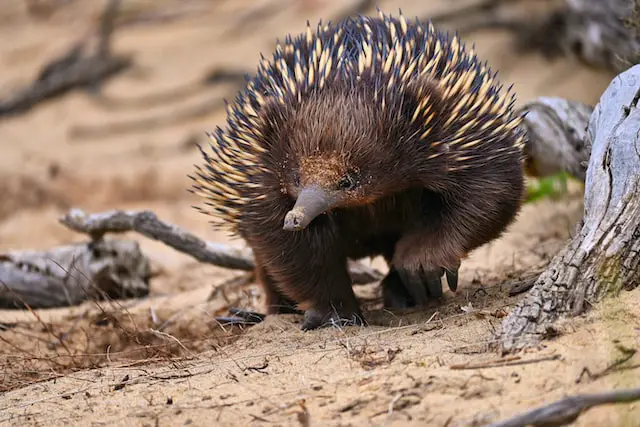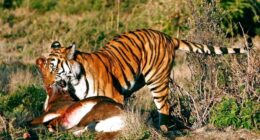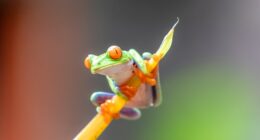Anteaters are insectivores, meaning they primarily eat insects, while echidnas are mainly carnivores and eat meat.
The anteater
(Photo by David Waite on Unsplash )

Anteaters are mammals that are native to Central and South America. They are known for their long snouts and sticky tongues, which they use to feast on ants and termites. Anteaters belong to the order Pilosa and are the only species in the genus Myrmecophaga.
Anteaters have a slow metabolism and a low body temperature, which allows them to conserve energy as they search for food. They are solitary animals that spend most of their time foraging for ants and termites. They have a keen sense of smell that they use to locate their prey, and they use their long snouts and sticky tongues to extract insects from their nests.
There are three species of anteaters: the giant anteater, the tamandua, and the silky anteater. The giant anteater is the largest of the three, measuring up to seven feet in length. Tamanduas are smaller, measuring about three feet in length, and silky anteaters are the smallest, measuring only about a foot in length.
Giant Anteater:
The giant anteater (Myrmecophaga tridactyla) is a species of anteater native to Central and South America. It is the largest of all anteater species and can grow up to 7 feet long, including its tail. The giant anteater has a long, slender snout that is covered in sensory hairs, which it uses to locate ant and termite nests. It also has long, sharp claws on its front feet that it uses to tear open the nests. The giant anteater is a solitary animal that is primarily active during the day and feeds on ants and termites.
Tamandua:
The tamandua (Tamandua tetradactyla) is a species of anteater that is found in Central and South America. It is smaller in size compared to the giant anteater and can grow up to 4 feet long, including its tail. The tamandua has a prehensile tail that it uses to cling to trees and balance while it feeds. It has a short snout and a long, sticky tongue that it uses to extract ants and termites from their nests. The tamandua is active both during the day and night and is known to be more social than the giant anteater.
Silky Anteater:
The silky anteater (Cyclopes didactylus) is a species of anteater that is found in Central and South America. It is the smallest of the anteater species and can grow up to 1 foot long. The silky anteater has a long, slender body that is covered in silky, golden-brown fur. It has a short snout and a long, sticky tongue that it uses to feed on ants and termites. The silky anteater is primarily active at night and is known to be a solitary animal.
Differences between the three
- Tail: The tamandua has a prehensile tail, while the giant anteater and silky anteater do not.
- Location: All three species of anteaters are native to Central and South America.
- Size: The giant anteater is the largest of the anteater species, followed by the tamandua, and then the silky anteater.
- Snout: The giant anteater has a longer snout compared to the tamandua and the silky anteater.
- Diet: All three species of anteaters feed on ants and termites.
- Social Behavior: The tamandua is known to be more social compared to the giant anteater and silky anteater, which are solitary animals.
- Activity Level: The silky anteater is primarily active at night, while the giant anteater and tamandua are active during the day and night.
The echidna
(Photo by Enguerrand Blanchy on Unsplash )

Echidnas, also known as spiny anteaters, are native to Australia and New Guinea. Unlike anteaters, echidnas are covered in spines, which serve as a defense mechanism against predators. Echidnas belong to the order Monotremata, which means that they are one of the only species of mammals that lay eggs instead of giving birth to live young.
Echidnas are solitary animals that are most active during the night and early morning. They are slow-moving and spend much of their time resting in burrows. When threatened, they curl up into a ball and use their spines as a barrier to protect themselves.
There are two species of echidnas: the short-beaked echidna and the long-beaked echidna. The short-beaked echidna is found throughout Australia, while the long-beaked echidna is only found in New Guinea. Echidnas feed on ants, termites, and other insects, which they dig out of the ground using their sharp claws.
There are only two species of echidnas: the short-beaked echidna (Tachyglossus aculeatus) and the long-beaked echidna (Zaglossus bruijni).
Short-beaked Echidna:
The short-beaked echidna is the more widely distributed species and can be found in Australia and New Guinea. It has a shorter snout and shorter spines compared to the long-beaked echidna. The short-beaked echidna feeds mainly on ants and termites and uses its long, sticky tongue to extract them from their nests. It is known to be solitary and primarily active during the day.
Long-beaked Echidna:
The long-beaked echidna is a species that is found in New Guinea and the surrounding islands. It has a longer snout and longer spines compared to the short-beaked echidna. The long-beaked echidna feeds mainly on earthworms and other invertebrates, using its long snout to dig them out of the ground. It is also known to be solitary and primarily active during the day.
Differences between the two
- Snout: The long-beaked echidna has a longer snout compared to the short-beaked echidna.
- Spines: The long-beaked echidna has longer spines compared to the short-beaked echidna.
- Diet: The short-beaked echidna feeds mainly on ants and termites, while the long-beaked echidna feeds mainly on earthworms and other invertebrates.
- Location: The short-beaked echidna is found in Australia and New Guinea, while the long-beaked echidna is found in New Guinea and the surrounding islands.
- Activity Level: Both species of echidnas are solitary and primarily active during the day.
The Key Differences Between Anteaters and Echidnas
While anteaters and echidnas may look similar, there are several key differences that set them apart from one another. Some of the most notable differences include:
Physical Characteristics:
Anteaters and Echidnas are both unique-looking animals with distinct physical characteristics.
Anteaters are known for their elongated snouts, which they use to locate and extract ants and termites from their nests. They have a long, shaggy coat that is typically grey or black and white in color, and they have long, sharp claws on their front feet that they use to tear open ant and termite nests. Anteaters can grow up to 7 feet long, including their tails.
Echidnas, on the other hand, are small, spiny mammals that are often referred to as “spiny anteaters.” They have a small, slender snout and a distinctive coat of spines that covers their bodies, making them well-protected against predators. Unlike anteaters, echidnas have short, sturdy legs and are able to burrow into the ground for protection.
Behavior:
Anteaters are solitary animals that spend most of their time foraging for food and avoiding contact with other animals. They are active during the day and sleep at night, and they tend to be slow-moving and sluggish.
Echidnas, on the other hand, are more social and can be found in small groups. They are active both day and night and are known for their ability to burrow into the ground for protection. When threatened, echidnas will curl up into a tight ball, using their spines to deter predators.
Diet:
Anteaters are primarily insectivores and feed on ants and termites. They have a highly specialized tongue that is long and sticky, allowing them to efficiently extract insects from their nests.
Echidnas are omnivores and feed on a variety of foods, including ants, termites, worms, and other small insects. They also consume plants, fruits, and roots.
Reproduction:
Anteaters give birth to a single offspring at a time, and the mother will care for the young for several months before it becomes independent.
Echidnas are monotremes, which means that they lay eggs rather than giving birth to live young. After the eggs hatch, the young are fed on milk from the mother until they are ready to venture out on their own.
Habitat:
Anteaters are found in a variety of habitats, including grasslands, forests, and savannas. They are native to Central and South America.
Echidnas are found in a variety of habitats throughout Australia and New Guinea, including forests, deserts, and grasslands.
Location:
Anteaters are native to Central and South America, and they can be found in countries such as Argentina, Brazil, and Peru.
Echidnas are native to Australia and New Guinea, and they are found throughout the region.
Temperament:
Anteaters are generally solitary and shy, avoiding contact with other animals whenever possible. They are slow-moving and sluggish, and they tend to be peaceful and gentle in nature.
Echidnas are more social and can be found in small groups. They are known for their protective spines and can be aggressive when threatened. However, they are generally peaceful and not known to be aggressive towards humans.
Featured Image By Nareeta Martin on Unsplash









